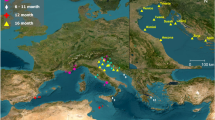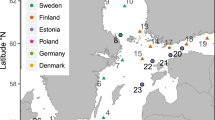Abstract
This study presents analysis of acoustic data of underwater sound emitting vessels (USEV) recorded during operation in the Dublin Bay port area. Investigations were carried out to assess the magnitudes of these underwater sounds, and also the potential effect of changes in tidal states on these sound signals and their propagation. Power spectral densities (PSD) and 1/3 octave band sound pressure levels (SPL) were computed for frequencies between 50–500 and 50–1000 Hz, respectively. During the presence of these vessels in the study site, broadband SPL values for a range of frequency components were calculated to be between 94 and 121 dB (re 1 µPa) at a distance of 200 m from the vessels. These values decreased by 5–21 dB during their absence. The strongest sound level recorded at this site was during the departure of vessels from the dock at 200 m from the recording system. The SPL value calculated during this operational period at 315 Hz frequency was 121 dB re 1 µPa2/Hz. Associated components’ spectral of the vessels were identified, and the effect of difference in heights of tidal ranges (Neap/Spring) on this site was investigated.








Similar content being viewed by others
References
Gloza I (2009) Ship’s underwater noise measurements using sound intensity method. Hydroacoustics 12:53–60
Broudic M, Croft N, Willis M, Masters I, Sei-Him C (2014) Comparison of underwater background noise during Spring and Neap tide in a high tidal current site: Ramsey Sound. In: Proceedings of meetings on acoustics, vol. 17, no. 1, p 070104
Willis MR, Broudic M, Haywood C, Masters I, Thomas S (2013) Measuring underwater background noise in high tidal flow environments. Renew Energy 49:255–258
Willis MR, Broudic I, Masters I (2011) Ambient underwater noise in high and low energy flow conditions. In: 4th Wind Turbine Noise Conference 2011 (WTNC 2011), Rome, Italy
Bassett C, Thomson J, Polagye B, Rhinefrank K (2011) Underwater noise measurements of a 1/7 th scale wave energy converter. In: OCEANS 2011, IEEE. pp 1–6
Ikpekha OW, Soberon F, Daniels S (2014) Modelling the propagation of underwater acoustic signals of a marine energy device using finite element method. In: Presented at the international conference on renewable energies and power quality, Cordoba, Spain, 2014
Mazzuca LL (2001) Potential effects of low frequency sound (LFS) from commercial vessels on large whales. Thesis Submitted to University of Washington
McKenna MF, Ross D, Wiggins SM, Hildebrand JA (2012) Underwater radiated noise from modern commercial ships. J Acoust Soc Am 131(1):92–103
Pricop M, Chitac V, Gheorghe F, Papzara T, Oncica V, Atodiresei D (2010) Underwater radiated noise of ships’ machinery in shallow water. In: Conference on manufacturing engineering, quality and production systems, Romania, 2010
Lee S, Lee Y, Kim S, Park J, Rak J (2010). Measurement of low frequency ambient noise using screened hydrophone in shallow water. In: Proceedings of symposium on ultrasonic electronics, vol. 31, no. 2010, pp 421–422
Hildebrand J (2004) Sources of anthropogenic sound in the marine environment. In: Report to the policy on sound and marine mammals: an international workshop. US Marine Mammal Commission and Joint Nature Conservation Committee, UK. London, England, 2004
McKenna MF, Wiggins SM, Hildebrand JA (2013) Relationship between container ship underwater noise levels and ship design, operational and oceanographic conditions. Sci Rep 3:1760. doi:10.1038/srep01760
Würsig B, Greene C Jr (2002) Underwater sounds near a fuel receiving facility in western Hong Kong: relevance to dolphins. Mar Environ Res 54(2):129–145
Erbe C, McCauley R, McPherson C, Gavrilov A (2013) Underwater noise from offshore oil production vessels. J Acoust Soc Am 133(6):EL465–EL470
Hildebrand JA (2009) Anthropogenic and natural sources of ambient noise in the ocean. Mar Ecol Prog Ser 395:5–20
Briciu-Burghina C, Sullivan T, Chapman J, Regan F (2014) Continuous high-frequency monitoring of estuarine water quality as a decision support tool: a Dublin Port case study. Environ Monit Assess 186:5561–5580. doi:10.1007/s10661-014-3803-9
Bedri Z, Bruen M, Dowley A, Masterson B (2013) Environmental consequences of a power plant shut-down: a three-dimensional water quality model of Dublin Bay. Mar Pollut Bull 71(1):117–128
Proakis JG, Sozer EM, Rice JA, Stojanovic M (2001) Shallow water acoustic networks. Commun Mag IEEE 39(11):114–119
Purcell M, Vasudevan A, Gregg D (2012) Real-time sensor signal capture from a harsh environment. In: Distributed simulation and real time applications (DS-RT), 2012 IEEE/ACM 16th international symposium on, 2012, IEEE. pp 36–43
Kolar H et al (2013) The design and deployment of a real-time wide spectrum acoustic monitoring system for the ocean energy industry. In: OCEANS-Bergen, 2013 MTS/IEEE, IEEE, pp 1–4
Jensen F, Kuperman W, Porter M, Schmidt H, Tolstoy A (2008) Computational ocean acoustics. Phys Today 47(11):91–92
Nedwell J (2010) Measurements of baseline underwater noise and vibration in Sruwaddacon Bay, Co. Mayo, Eire, Subacoustech Enviromental Report No. E270R103, ed, 21 Aug 2010
Zak A (2011) Ship’s hydroacoustics signatures classification using neural networks. In: Mwasiagi JI (ed) Self organizing maps—applications and novel algorithms design. INTECH, Rijeka, Croatia
Farcas A, Thompson PM, Merchant ND (2016) Underwater noise modelling for environmental impact assessment. Environ Impact Assess Rev 57:114–122
Acknowledgements
O. Ikpekha and S. Daniels specifically acknowledge the Irish Research Council (IRC) for funding this project. A. Eltayeb and S. Daniels thank the postgraduate funding support from INSPIRE (Irish government’s PRTLI cycle 5, national development plan 2007–2013—European regional development fund).
Author information
Authors and Affiliations
Corresponding author
About this article
Cite this article
Ikpekha, O.W., Eltayeb, A., Pandya, A. et al. Operational noise associated with underwater sound emitting vessels and potential effect of oceanographic conditions: a Dublin Bay port area study. J Mar Sci Technol 23, 228–235 (2018). https://doi.org/10.1007/s00773-017-0468-4
Received:
Accepted:
Published:
Issue Date:
DOI: https://doi.org/10.1007/s00773-017-0468-4




